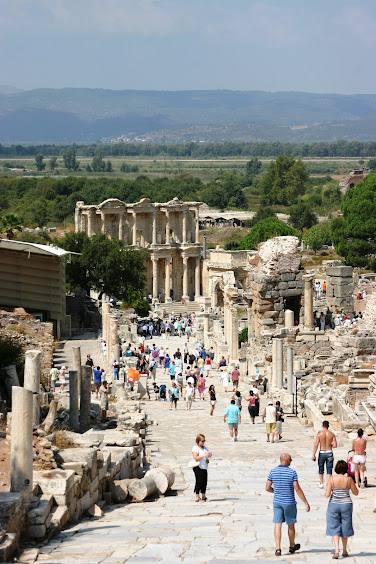Curetes Street
Curetes Street is always full of people. They come from all over rld to see the dug up, cleaned up, tastefully reconstructed metropolis of Ephesus. As you walk down this avenue of long-ago splendor, you hear snippets of all the languages you think you recognize and just as many that you don’t.
Each time I visited Ephesus, I liked to linger a while by the State Agora, where this picture was taken, to admire the panoramic view, past Hadrian’s Temple on the right and the on the Terrace Houses on the left, down to the elegant façade of the Library of Celsus, and beyond the Library, beyond the colonnaded quadrangle of the Agora, what remains lay beneath the distant orange groves, the legendary academy for gladiators? The route of the Sacred Way?—(which features in my story about Herostratus).
The Curetes in Greek mythology were guardian spirits assigned by Rhea to
protect the infant Zeus from Cronos, his infanticidal father. The Curetes
banged their shields with their spears to produce a hullaballoo that hid the
cries of the newborn babe. This myth was later adapted to the birth of Artemis
in Ortygia, a sacred grove that some commentators placed in close proximity to
Ephesus. Here, Leto was the mother, Zeus the father, and Hera the murderous
wife. The Curetes from then on became guardians of the goddess. In Ephesus,
their role was ritually enacted by a select group of priests. The steet takes
its name from an inscription found nearby. It names the priests and
acknowledges their responsibility for guarding the everlasting flame that
symbolized the life and wellbeing of the city.
The modern names for the streets of Ephesus are not the original names, most of which have been lost. We do know from inscriptions and other evidence that Curetes Street was once called the Embolos, and the road connecting the Embolos to the harbor, now called Harbor Street, was once the Arcadienne.
 |
| The Communal Toilet |
Other locations have taken on a new significance that would have seemed
strange and maybe hilarious to early inhabitants. Nothing in the city at that
time could have been less remarkable than the public toilet. But the public
toilet across the street from the Terrace Houses might now be the most
photographed location in the city. Tour guides love to talk about it, and tourists
feel compelled to have their pictures taken while squatting, fully clothed, of
course, on one of the 48 holes. Today, we would balk at the needj to relieve
ourselves in public, but the inhabitants of Ephesus, it seems, had no such
reticence.
 |
| Two Bowlers |
One tour guide explained to me that the generous folds of a toga offered Roman gentlemen some privacy, ignoring the fact that Romans in togas were a tiny minority, all men, all Roman citizens, and only when dressed for work—rather like bowler hats and rolled umbrellas in London.
Another anachronistic modernism is the so-called brothel. In the ruins of a house behind the toilet, archeologists found a little statue of the god Priapus. He can be seen in the Ephesus museum. He's only inches tall, and his penis is almost as tall as himself. On that basis alone, the house has acquired the reputation of a brothel.
 |
In the roadway alongside the agora, one might notice the outline of a foot-print carved in the stone pavement. Careful scrutiny reveals a woman in a headdress, and a crudely chiseled heart. Amateur historians have concoct-ed a titillating story connecting these graffiti to the brothel. They have become a coded adver-tisement for the purpose of guiding sailors coming from the harbor in search of sex.
 |
But erotic art was not unusual in respectable Roman houses, and brothels had no need for secret codes to bring in customers, Just look at the openly erotic paintings all over Pompeii and Herculaneum.
https://travelpast50.com/erotic-art-pompeii-herculaneum/

Comments
Post a Comment